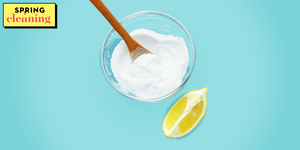While we all want our household surfaces to sparkle and shine, it’s not just their overall look that matters: All frequently-touched surfaces need to be disinfected regularly, too. Sure, some of the items in your pantry or refrigerator (think: vinegar and lemon juice) may effectively clean your countertops, sinks, and other high-traffic spots, but they aren’t packed with the right ingredients to properly disinfect your space. That doesn’t mean that you have to turn to traditional all-purpose cleaners to get the job done, though.
When used properly, natural disinfectants made with plant-based ingredients can be just as effective as chemical cleaners. But not all natural cleaners are created equally: To make sure that you’re buying cleaners approved by the U.S. Environmental Protection Agency, look for products with ingredients like thymol, including Seventh Generation Disinfecting Wipes and Cleaners. No matter if it’s a spray or wipe, these natural disinfectants kill bacteria and viruses on hard surfaces, but they work more slowly than chemical disinfectants. To disinfect properly, clean the surface with soap and water before using your disinfectant of choice, and let sit for at least 10 minutes, depending on the product instructions, to kill 99.999% of germs.
To note: All cleaners that claim to kill germs require EPA registration. It’s what the Good Housekeeping Cleaning Lab uses as a guide when we test sanitizers and disinfectants, and it implies that if you follow the directions, then the product will work as claimed. With that being said, here are a few pointers about how to disinfect, whether you opt for natural or chemical products:
- Sanitizing is not the same as disinfecting. Sanitizing (reduces the risk of illness by killing 99.9% of germs) usually takes less time — sometimes just 30 or 60 seconds — while disinfecting (killing 99.999% of germs) can take anywhere up to 10 minutes, depending on the product.
- Check the label for how long hard, non-porous surfaces must stay wet for the most effective germ killing. Because liquids evaporate, you may have to apply the product several times.
- No product can adequately sanitize or disinfect a dirty surface, so make sure you clean — even with plain soap and water — before you disinfect.
- Regular soap and water cleans germs away, but sanitizing and disinfecting products are required to kill germs.
- Soft surfaces are porous and will never reach the level of germ kill required to be fully disinfected.
- Never combine disinfecting or any cleaning products (bleach and vinegar, for example) and open the window or ventilate a room if fumes become bothersome.
- Test surfaces in a hidden spot before using alcohol, hydrogen peroxide, or any disinfectant on a surface, especially a delicate one. On food contact surfaces, rinse with clear water and dry after disinfecting, unless the product label specifically says otherwise.
Are vinegar or lemon juice effective disinfectants?
In short, no. While the citric acid in lemons or acetic acid in vinegar kills some bacteria and are EPA-registered active ingredients, the concentration and PH levels aren’t powerful enough to disinfect in the same way as other EPA-registered cleaners. But if you’re simply looking to spruce up your countertop, refrigerator, or other hard-hit surface, then they’ll at least make it look cleaner than before.
Is rubbing alcohol or hydrogen peroxide a smart option?
It’s up for debate whether or not rubbing alcohol and hydrogen peroxide are considered natural cleaners, but one thing’s for sure: They’re both solid alternatives to chemical disinfectants. Higher percentages of alcohol evaporate too quickly to be effective, so it’s best to stick with a rubbing alcohol containing 70% isopropyl alcohol or a 3% hydrogen peroxide solution. Dilute it slightly (two thirds alcohol and one third water) before using and let it sit — rubbing alcohol for at least 30 seconds and hydrogen peroxide for at least one minute — before wiping clean.
Even though you can use these homemade cleaners on household surfaces, save them to disinfect smaller objects like thermometers. Because these alcohol solutions are extremely evaporative, they don’t work well on hard, non-porous surfaces.
What about steam cleaners?
Yes, steam is an effective way to kill bacteria and other germs without chemicals. Don’t reach for your trusty garment steamer, though: Household steam cleaners, like the Bissell SteamShot Deluxe, reach temperatures high enough to kill germs on hard household services. The catch: Steam must have direct contact with the surface for a long period of time to be effective. Follow the procedure in your steamer’s owner manual for the best results.
Source: Home Ideas - goodhousekeeping.com




